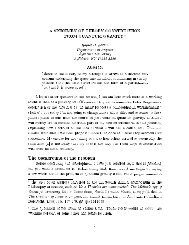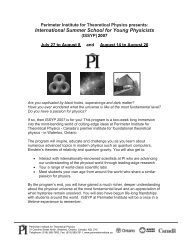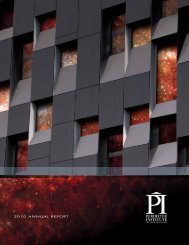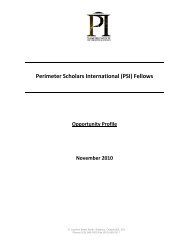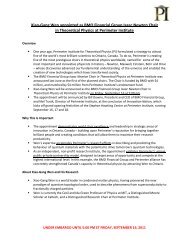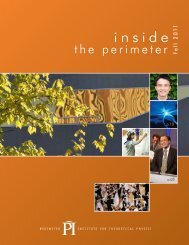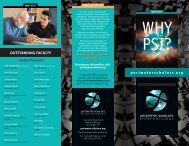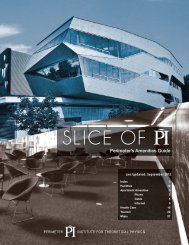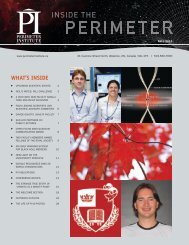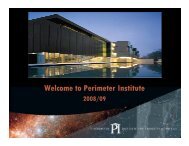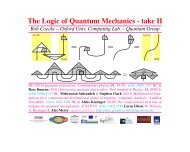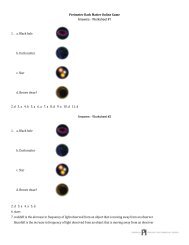Information Drawn from the 2006 NSERC Review of Perimeter Institute
Information Drawn from the 2006 NSERC Review of Perimeter Institute
Information Drawn from the 2006 NSERC Review of Perimeter Institute
You also want an ePaper? Increase the reach of your titles
YUMPU automatically turns print PDFs into web optimized ePapers that Google loves.
Detailed <strong>Information</strong> drawn <strong>from</strong><strong>2006</strong> <strong>NSERC</strong> <strong>Review</strong> <strong>of</strong> <strong>Perimeter</strong><strong>Institute</strong>Table <strong>of</strong> ContentsCommittee Members............................................................................................. 11Procedure .............................................................................................................. 12Summary............................................................................................................... 12Research................................................................................................................ 15Outreach................................................................................................................ 22Management.......................................................................................................... 22Budget................................................................................................................... 24Canadian Issues..................................................................................................... 24Concluding Remarks and Recommendations ....................................................... 2710
Committee MembersSeptember 26, <strong>2006</strong>Mark Wise-Caltech (Chair)Andrew Cohen-Boston UniversityArthur Hebecker-Heidelberg UniversityGerard Milburn-University <strong>of</strong> QueenslandBill Peters-TELUS World <strong>of</strong> Science / CalgaryCarlo Rovelli-Université de la Méditerranée / MarseilleJohn Smolin-IBMWilliam Trischuk-University <strong>of</strong> Toronto and <strong>Institute</strong> <strong>of</strong> Particle PhysicsLynann Clapham*-Queen’s University (Representing <strong>the</strong> Major Resources GSC)Alan Coley*-Dalhousie University (Representing <strong>the</strong> Space and Astronomy GSC)Harold Haugen*-McMaster University (Representing <strong>the</strong> General Physics GSC)Byron Jennings*-TRIUMF (Representing <strong>the</strong> Subatomic Physics GSC)* Ex-<strong>of</strong>ficio member.11
ProcedureThe committee met on September 6-7, <strong>2006</strong> at <strong>Perimeter</strong> <strong>Institute</strong> forTheoretical Physics (PI) and performed an in-depth review <strong>of</strong> PI’s pastaccomplishments and future plans. Presentations were made by Research Faculty,<strong>the</strong> Executive Director Howard Burton and <strong>the</strong> Director <strong>of</strong> Scientific Outreach,Damian Pope. The committee also met with <strong>the</strong> Chair <strong>of</strong> <strong>the</strong> Scientific AdvisoryCommittee, Paul Steinhardt, several members <strong>of</strong> <strong>Perimeter</strong> <strong>Institute</strong>’s Board <strong>of</strong>Directors, and with some postdoctoral scholars and graduate students. In addition,informal discussions with members <strong>of</strong> PI and its Board <strong>of</strong> Directors occurred duringa lunch and a dinner on <strong>the</strong> first day <strong>of</strong> <strong>the</strong> meeting. The committee had several incamera discussion sessions where conclusions were drawn. A closing session, where<strong>the</strong> committee’s conclusions were summarized in an oral presentation to PI’sparticipants occurred at <strong>the</strong> end <strong>of</strong> <strong>the</strong> meeting. Following <strong>the</strong> meeting, <strong>the</strong>committee members corresponded via email and drafted this report.SummaryMain Conclusions• PI has been a great success on a world-wide scientific scale, for Canadianscience, and for education and outreach. A number <strong>of</strong> major researchachievements can be attributed directly to <strong>the</strong> existence <strong>of</strong> PI. The <strong>Institute</strong>should be applauded for its success in attracting such high qualityresearchers.• PI has outstanding management. It provides strong oversight while retaining<strong>the</strong> creativity and flexibility needed for a rapidly growing enterprise. PI’splans for <strong>the</strong> future are excellent and <strong>the</strong> <strong>Institute</strong> appears very wellprepared to move ahead with its proposed plans for <strong>the</strong> next five years.• We strongly support PI’s request for government funding to its full extentand for a period <strong>of</strong> at least 5 years.General SummaryPI was founded just seven years ago, and since that time has developed anexcellent international reputation as a leading center for some <strong>of</strong> <strong>the</strong> importantareas <strong>of</strong> foundational physics. Their most developed groups are in quantuminformation <strong>the</strong>ory, quantum gravity and string <strong>the</strong>ory. In addition <strong>the</strong>y havesmaller, but high-caliber, groups in foundations <strong>of</strong> quantum mechanics andcosmology, and a nascent effort in <strong>the</strong>oretical particle physics. At <strong>the</strong> present timeparticle physics is not represented by any permanent faculty at <strong>Perimeter</strong>, but onlythrough associates and visitors. Developing world class research groups in some <strong>of</strong><strong>the</strong> most important areas in <strong>the</strong>oretical physics over such a short period <strong>of</strong> time is aremarkable accomplishment. They have also developed a highly successful and verycreative outreach program that inspires and educates pre-college students and highschool teachers in science, and includes a highly successful lecture series for <strong>the</strong>general public.12
It is PI’s intention to grow its efforts in foundational physics over <strong>the</strong> next fiveyears, resulting in a doubling <strong>of</strong> <strong>the</strong> faculty and postdoctoral scholars at PI. Theyhope in this process to greatly streng<strong>the</strong>n <strong>the</strong>ir efforts in foundations <strong>of</strong> quantum<strong>the</strong>ory, cosmology and particle physics. Given <strong>the</strong>ir exceptional track record wethink that this ambitious goal is realistic and recommend enthusiastically that PIcontinue to be strongly supported by Canada’s federal government.PI recognized early that <strong>the</strong> emerging area <strong>of</strong> quantum information was underappreciated by <strong>the</strong> general academic community, and was <strong>the</strong>refore a subject wherea newly formed institute could have a large impact. Although it now seems that thiswas an obvious course <strong>of</strong> action, we must not forget that many strategies that seemobvious in hindsight actually require great insight to pursue. The associatesprogram, in which high caliber scientists commit to spending at least three months<strong>of</strong> <strong>the</strong> year at PI, played a crucial role in this success. It helped streng<strong>the</strong>n <strong>the</strong> effortat <strong>the</strong> University <strong>of</strong> Waterloo, that now has a center for quantum information andquantum computing (<strong>the</strong> <strong>Institute</strong> for Quantum Computing, IQC). Toge<strong>the</strong>r, PI andIQC (which includes some PI associates) make <strong>the</strong> Waterloo area one <strong>of</strong> <strong>the</strong> premiersites for quantum computing, capable <strong>of</strong> competing for <strong>the</strong> best postdocs, faculty andvisitors in <strong>the</strong> field.Reconciling gravity with quantum mechanics is one <strong>of</strong> <strong>the</strong> most widelyrecognized foundational issues in modern <strong>the</strong>oretical physics, and it is appropriatefor PI to have a strong presence in this area <strong>of</strong> study. String <strong>the</strong>ory, providing aunified framework for quantum gravity along with <strong>the</strong> o<strong>the</strong>r forces <strong>of</strong> nature, is one<strong>of</strong> <strong>the</strong> core areas <strong>of</strong> modern <strong>the</strong>oretical physics and is strongly supported by <strong>the</strong>university system, <strong>the</strong>oretical institutes and national laboratories. O<strong>the</strong>r approachesfor quantizing <strong>the</strong> gravitational interaction such as loop quantum gravity are lesswidely supported. PI has a strong, world-class effort both in string <strong>the</strong>ory and loopquantum gravity, as well as an active involvement in o<strong>the</strong>r approaches to quantumgravity. This is consistent with PI’s philosophy <strong>of</strong> supporting both orthodox andunorthodox approaches to foundational questions. Quantum gravity is an especiallyappropriate area in which to adopt this philosophy. For example, it was not that longago that string <strong>the</strong>ory was studied by only a few <strong>the</strong>orists. Although <strong>the</strong>y wereconsidered to be talented scientists working on a subject <strong>of</strong> great importance, mostjudged that <strong>the</strong> chances <strong>of</strong> significant progress were at best marginal. It isparticularly impressive that in an area like string <strong>the</strong>ory, where competition <strong>from</strong><strong>the</strong> university system and o<strong>the</strong>r international centers for <strong>the</strong> best researchers isfierce, PI has never<strong>the</strong>less been able to build up a strong effort.Even though PI is a center for <strong>the</strong>oretical physics, <strong>the</strong> committee notes that, evenin abstract fields like string <strong>the</strong>ory, quantum gravity and foundations <strong>of</strong> quantum<strong>the</strong>ory, <strong>the</strong>re is a significant effort to make contact with experiment andobservations. This is very important for any physics organization, but not alwaysrealized at those institutes focusing on <strong>the</strong>ory. Without it, PI would risk becoming acenter for ma<strong>the</strong>matics ra<strong>the</strong>r than foundational issues in <strong>the</strong>oretical physics. In <strong>the</strong>area <strong>of</strong> quantum information <strong>the</strong>ory it is likely that, in <strong>the</strong> not too distant future,<strong>the</strong>re will be “real world” applications <strong>of</strong> <strong>the</strong> concepts and methods that are nowbeing developed. The strength <strong>of</strong> PI in this area might provide Canada withtechnical expertise <strong>of</strong> significant economic importance.PI has one member <strong>of</strong> its faculty studying foundations <strong>of</strong> quantum <strong>the</strong>ory andano<strong>the</strong>r one working on cosmology. Foundations <strong>of</strong> quantum <strong>the</strong>ory, like non-string13
experiment only a few years ago, Canada now has one <strong>of</strong> <strong>the</strong> largest national effortsin quantum information in <strong>the</strong> world.PI has seeded this development <strong>of</strong> QI in Canada through first-rate facultyappointments, postdocs and strategic associate staff appointments. It is alsoresponsible for bringing Raymond Laflamme to Canada and nurturing <strong>the</strong> resultingdevelopment <strong>of</strong> <strong>the</strong> <strong>Institute</strong> for Quantum Computing (IQC) at <strong>the</strong> University <strong>of</strong>Waterloo.A number <strong>of</strong> major research achievements in QI can be attributed directly to <strong>the</strong>existence <strong>of</strong> <strong>the</strong> <strong>Perimeter</strong> <strong>Institute</strong>. One <strong>of</strong> <strong>the</strong> most exciting is <strong>the</strong> developingprograms at <strong>the</strong> interface between QI and quantum gravity. This is unique, highlyinnovative and likely to have lasting and significant impacts on both fields. Already,we have seen new results in loop quantum gravity inspired by <strong>the</strong> tools andtechniques <strong>of</strong> quantum information.Work on topics more directly related to quantum computation has been carriedout both by PI faculty and associates, especially those with joint appointment at <strong>the</strong>IQC. This close collaboration <strong>of</strong> a large group <strong>of</strong> researchers has led to progress on anew class <strong>of</strong> quantum codes (operator error correction) and an improvedunderstanding <strong>of</strong> <strong>the</strong> vitally important (if practical quantum computers are somedayto be built) threshold for fault-tolerant quantum computing. There is also ongoingwork on new types <strong>of</strong> quantum algorithms (for example, search by quantum walks)and quantum cryptographic topics (secure computation, practical quantum keydistribution).One area that has not yet been developed in this remarkable build up <strong>of</strong>capability in quantum information is <strong>the</strong> link between QI and condensed matterphysics. A condensed matter program at PI may lead to research collaborationsmirroring <strong>the</strong> productive links between quantum gravity and QI. There have beensome exciting developments in foundations <strong>of</strong> many body quantum <strong>the</strong>ory and QIthat are having a significant impact on <strong>the</strong> field (for example, connections betweendensity matrix renormalization group and quantum information <strong>the</strong>ory). If anopportunity to make a first rate appointment in this area does arise, we believe itshould be grasped.PI has also had an impact on graduate education in <strong>the</strong> surrounding universities.Access to international leaders in <strong>the</strong> field gives local PhD students a wonderfulopportunity to participate at <strong>the</strong> highest levels in QI. The new course on QuantumFoundations developed by Ray Laflamme and o<strong>the</strong>rs gives a good example <strong>of</strong> how<strong>the</strong> resources <strong>of</strong> <strong>the</strong> <strong>Institute</strong> can be leveraged to provide unique opportunities forlocal graduate students. Fur<strong>the</strong>r development <strong>of</strong> <strong>the</strong>se innovative teachinginitiatives should be encouraged and a means found to share <strong>the</strong> results with moreCanadian universities.Ideas <strong>from</strong> quantum information <strong>the</strong>ory have reinvigorated <strong>the</strong> field <strong>of</strong> quantumfoundations. Taking an informational viewpoint gives a fresh perspective on oldquestions and PI is well positioned to exploit <strong>the</strong>se connections with its program onfoundations <strong>of</strong> quantum <strong>the</strong>ory. An exciting example <strong>of</strong> <strong>the</strong> work at PI at <strong>the</strong>interface between quantum information and foundations is <strong>the</strong> “toy model” (based on16
classical mechanics with restricted availability <strong>of</strong> information) which recovers many,but not all, features <strong>of</strong> quantum <strong>the</strong>ory, thus more clearly delineating what is noveland needs explaining in quantum <strong>the</strong>ory. It is likely that synergies will developbetween <strong>the</strong> foundations, quantum information, quantum gravity and cosmologygroups, as has happened with those groups already in place.Foundations <strong>of</strong> Quantum TheoryThe Foundations <strong>of</strong> Quantum Theory group includes one faculty (Lucien Hardy),five postdocs (Alexei Grinbaum, Owen Maroney, Ward Struyve, Hans Westman,Samuel Colin) and five long term visitors (Jeffrey Bub, Paul Busch, Joy Christian,Rafael Sorkin and Antony Valentini).The establishment <strong>of</strong> quantum <strong>the</strong>ory as <strong>the</strong> most effective description <strong>of</strong> <strong>the</strong>physical world during <strong>the</strong> first third <strong>of</strong> <strong>the</strong> 20 th century was accompanied by anintense debate on <strong>the</strong> meaning <strong>of</strong> <strong>the</strong> physical and philosophical content <strong>of</strong> <strong>the</strong><strong>the</strong>ory. The immense phenomenological success <strong>of</strong> <strong>the</strong> <strong>the</strong>ory, <strong>the</strong> urge to apply it toincreasingly vast natural domains (atoms, nuclei, particles, condensed matter,plasma, lasers, neutron stars, etc.), as well as <strong>the</strong> dominant pragmatic philosophicalmood <strong>of</strong> <strong>the</strong> second half <strong>of</strong> <strong>the</strong> 20 th century, have left this debate in <strong>the</strong> background.As a technique to compute outcomes <strong>of</strong> measurements performed with physicalapparatuses considered classical, quantum mechanics can be viewed, and has beenviewed by a generation <strong>of</strong> physicists, as un-problematic. More recently, however, anincreasing number <strong>of</strong> physicists have begun to face <strong>the</strong> intrinsic incompleteness <strong>of</strong>this way <strong>of</strong> describing nature (apparatuses are <strong>the</strong>mselves quantum systems, afterall), <strong>of</strong>ten pushed by <strong>the</strong> conceptual problems raised by <strong>the</strong> development <strong>of</strong> fieldssuch as cosmology, or quantum gravity, where <strong>the</strong> pragmatic attitude mentionedabove finds itself quite strained. The debate on <strong>the</strong> foundations <strong>of</strong> quantummechanics has <strong>the</strong>refore resurfaced.This is a very positive development: today, facing major conceptual problemssuch as those raised by seeking a quantum <strong>the</strong>ory <strong>of</strong> spacetime, or describing <strong>the</strong>quantum physics near <strong>the</strong> initial cosmological singularity, <strong>the</strong>oretical physics can nolonger rely on <strong>the</strong> pragmatic attitude that has been so effective over <strong>the</strong> course <strong>of</strong> <strong>the</strong>past hundred years.Among <strong>the</strong> achievements <strong>of</strong> <strong>the</strong> group, is <strong>the</strong> pro<strong>of</strong> that any hidden variable<strong>the</strong>ory must have an infinite number <strong>of</strong> possible values; <strong>the</strong> definition <strong>of</strong>probabilistic <strong>the</strong>ories with indefinite causal structure (a development that couldhave hardly happened elsewhere than PI); and an intriguing investigation <strong>of</strong>possible observable cosmological effects <strong>of</strong> <strong>the</strong> Valentini’s version <strong>of</strong> <strong>the</strong> De Broglie-Bohm <strong>the</strong>ory (which testifies to <strong>the</strong> attention to empirical verifiability thatcharacterizes PI’s <strong>the</strong>oretical research). In a small field like Foundations <strong>of</strong>Quantum Theory, <strong>the</strong> PI group has rapidly become a reference, and we expect it toincreasingly play this role in <strong>the</strong> futureThe interests <strong>of</strong> <strong>the</strong> group cover a diversity <strong>of</strong> approaches and research directions(information <strong>the</strong>oretic approaches, hidden variable <strong>the</strong>ories, dynamical collapse17
models, foundational problems raised by quantum gravity), including a markedattention to <strong>the</strong> possibility <strong>of</strong> empirical verification <strong>of</strong> ideas and <strong>the</strong>oretical proposals(testing violations <strong>of</strong> quantum <strong>the</strong>ory in <strong>the</strong> early universe, testing local causalityusing EPR-Bell setup, testing Diosi-Penrose gravity induced collapse).The group plays an important role inside PI and in <strong>the</strong> international scientificenvironment. At present, <strong>the</strong> group relies strongly on long term visitors to achievean effective size. It would obviously find a more stable and effective configurationwith a larger number <strong>of</strong> faculty.String TheoryThe String Theory group currently consists <strong>of</strong> three faculty (Robert Myers,Jaume Gomis and Freddy Cachazo), one associate (Alex Buchel), six postdocs (SujayAshok, Evgeny Buchbinder, Xiao Liu, Christian Romelsberger, NemaniSuryanarayana, Andrei Starinets), one long term visiting faculty member (AmihayHanany), a number <strong>of</strong> visiting postdocs and five (or six) graduate students. This is alarge group, and <strong>the</strong> publication output has been correspondingly large. Theresearch topics are quite diverse, including string phenomenology, quantum gravityand blackholes, and string <strong>the</strong>oretic techniques applied to gauge field <strong>the</strong>ories.There are two especially noteworthy features <strong>of</strong> <strong>the</strong> string <strong>the</strong>ory effort at <strong>Perimeter</strong>.Firstly, it has a strong phenomenological character. The committee was impressedthat so much <strong>of</strong> <strong>the</strong> string <strong>the</strong>ory research (as well as o<strong>the</strong>r <strong>Perimeter</strong> researchareas) has focused on subjects with experimental and practical implications. Forexample, Rob Myers’ work on cosmic superstrings has potential implications forobservational cosmology; Jaume Gomis’ work on <strong>the</strong> open string landscape may haveapplication in <strong>the</strong> construction <strong>of</strong> realistic low-energy string models; and FreddyCachazo’s work on loop amplitudes in gauge field <strong>the</strong>ories may find application incalculations relevant for <strong>the</strong> LHC. Secondly, <strong>the</strong> research <strong>of</strong>ten has been informed byresults <strong>from</strong> o<strong>the</strong>r efforts at <strong>Perimeter</strong>, notably <strong>the</strong> quantum gravity and quantuminformation groups. For example, some <strong>of</strong> <strong>the</strong> work on black hole physics hasincorporated ideas developed by researchers in quantum information.It is also worth pointing out that this is an especially accomplished group in view<strong>of</strong> its youth. The initial appointment <strong>of</strong> Rob Myers, well-known for his seminal workon <strong>the</strong> physics <strong>of</strong> coincident D-branes, 5 years ago laid <strong>the</strong> foundation for strongstring effort. Following <strong>the</strong> recent appointments <strong>of</strong> Jaume Gomis and FreddyCachazo in <strong>the</strong> fall <strong>of</strong> 2004 and spring <strong>of</strong> 2005 respectively, <strong>the</strong> group has coalescedinto a cohesive whole, while demonstrating substantial breadth. The committee isalso impressed at <strong>the</strong> ability <strong>of</strong> <strong>the</strong> group to sustain such a high level <strong>of</strong> activity withonly three faculty. They have achieved this through judicious use <strong>of</strong> <strong>the</strong>ir programs<strong>of</strong> associates, long term visitors, along with <strong>the</strong> large number <strong>of</strong> postdoctoral fellows.One measure <strong>of</strong> <strong>the</strong> quality <strong>of</strong> this group is <strong>the</strong> ability to attract excellentpostdocs, which <strong>the</strong>y have done consistently over <strong>the</strong> past few years. In addition,<strong>the</strong>y have hosted some <strong>of</strong> <strong>the</strong> world’s best string <strong>the</strong>orists as part <strong>of</strong> <strong>the</strong>ir visitorprogram. This has allowed <strong>the</strong>m to become a significant destination for string <strong>the</strong>ory18
esearch with only a modest faculty. The quality <strong>of</strong> <strong>the</strong>se visitors is a testament to<strong>the</strong> rapid success <strong>of</strong> <strong>the</strong> <strong>Institute</strong> in string <strong>the</strong>ory. They have also helped publicize<strong>the</strong>ir efforts by hosting numerous conferences and workshops.The expansion <strong>of</strong> <strong>the</strong> faculty last year to three is an important step in ensuringthat <strong>Perimeter</strong> establishes its own premier in-house research program with its ownidentity. The choice <strong>of</strong> faculty has been excellent, producing a remarkably balancedresearch effort, and <strong>Perimeter</strong> should be applauded for its success in attracting suchhigh quality researchers.Quantum GravityThe Quantum Gravity † group is internationally renowned, and <strong>of</strong>ten referred toas <strong>the</strong> pre-eminent group in this field. It is composed <strong>of</strong> three faculty (LaurentFreidel, Fotini Markopoulou and Lee Smolin), one associate (Thomas Thiemann),nine post-docs (Michele Arzano, Sundance Bilson-Thompson, Yujun Chen, BiancaDittrich, Sabine Hossenfelder, Richard Etera Livine, Ca<strong>the</strong>rine Meusburger, JamesRyan, Simone Speziale), one long term visitor (Kirill Krasnov), nine graduatestudents, and numerous o<strong>the</strong>r visitors.The interest <strong>of</strong> <strong>the</strong> group is centered around <strong>the</strong> approach to quantum gravityknown as “loop quantum gravity”, currently <strong>the</strong> most developed alternative to string<strong>the</strong>ory. It covers all major aspects <strong>of</strong> this approach, <strong>from</strong> its canonical formalism, toits covariant “spinfoam” formulation; <strong>from</strong> <strong>the</strong> exploration <strong>of</strong> <strong>the</strong> possibility <strong>of</strong>naturally incorporating matter, to <strong>the</strong> low energy limit <strong>of</strong> <strong>the</strong> <strong>the</strong>ory. The group alsostudies a number <strong>of</strong> o<strong>the</strong>r ideas and approaches to quantum gravity, includingtwistor <strong>the</strong>ory, causal sets, and dynamical triangulations. This openness tounorthodox ideas makes PI a uniquely vital and bubbling research center.The group has produced an impressive number <strong>of</strong> results and ideas that havemarked <strong>the</strong> development <strong>of</strong> <strong>the</strong> field. Among <strong>the</strong> numerous scientific results, <strong>the</strong>committee notes <strong>the</strong> derivation <strong>of</strong> a phenomenological effective <strong>the</strong>ory, where adeformation <strong>of</strong> <strong>the</strong> Poincaré group is realized, <strong>from</strong> full quantum gravity in 2+1dimensions; this result ties toge<strong>the</strong>r very different research directions in quantumgravity, possibly including an important indication on <strong>the</strong> possibility <strong>of</strong> studying itsphenomenology. We also remark on PI’s contribution to <strong>the</strong> pro<strong>of</strong> <strong>of</strong> a keyuniqueness <strong>the</strong>orem, <strong>the</strong> “LOST” <strong>the</strong>orem, that puts loop quantum gravity on firmerma<strong>the</strong>matical ground, and <strong>the</strong> recent computations <strong>of</strong> <strong>the</strong> quantum gravitationalcorrections to <strong>the</strong> graviton propagator. Finally, we mention a recent notable idea fora derivation <strong>of</strong> <strong>the</strong> matter content <strong>of</strong> <strong>the</strong> standard model <strong>from</strong> <strong>the</strong> braiding <strong>of</strong> <strong>the</strong>quantum gravitational spin network states <strong>of</strong> loop quantum gravity. This is for <strong>the</strong>moment a highly speculative idea, but should it be supported its importance wouldbe major.The Quantum Gravity group plays a pivotal role in PI, since it has vitalinteractions with all <strong>the</strong> o<strong>the</strong>r groups. A close net <strong>of</strong> collaborations with members <strong>of</strong>† We use this term to refer to approaches, o<strong>the</strong>r than string <strong>the</strong>ory, to <strong>the</strong> problem <strong>of</strong>quantizing gravity.19
<strong>the</strong> Quantum <strong>Information</strong> group has developed, and concepts used in quantuminformation have also proven useful in quantum gravity. This is a remarkabledevelopment that has been made possible by <strong>the</strong> special character <strong>of</strong> PI’s researchenvironment. The interaction is also strong with <strong>the</strong> small Foundation <strong>of</strong> QuantumMechanics group, motivated by numerous overlaps between <strong>the</strong> problems faced by<strong>the</strong>se two areas. Tentative applications <strong>of</strong> loop quantum gravity to cosmology (“loopcosmology”) are already well developed, and it is likely that <strong>the</strong> group will be able todevelop a constructive interaction also with a future cosmology group at PI. Thissynergy is scientifically important, since cosmology might be <strong>the</strong> best ground to testany tentative quantum <strong>the</strong>ory <strong>of</strong> gravity.But <strong>the</strong> committee has particularly appreciated <strong>the</strong> cordial and constructivedialog between <strong>the</strong> String and <strong>the</strong> Quantum Gravity groups. String <strong>the</strong>ory and LoopQuantum Gravity are alternative (tentative) answers to <strong>the</strong> same problem, which isone <strong>of</strong> <strong>the</strong> major open problems in fundamental physics; <strong>the</strong> debate between <strong>the</strong> twocamps—strings and loops—is sometimes fierce. The relation between <strong>the</strong> String andLoop groups at PI, however, is marked by a reciprocal attention and respect which,while not diminishing <strong>the</strong> intensity <strong>of</strong> <strong>the</strong> debate, provides a scientifically productiveclimate, and opens <strong>the</strong> way to mutual understanding and cross fertilization. Thecommittee views this relationship as a very positive realization <strong>of</strong> PI’s MissionStatement to “create a lively and dynamic research atmosphere where manyapproaches to fundamental questions, both orthodox and unorthodox, are pursuedsimultaneously”.The senior member <strong>of</strong> <strong>the</strong> group is Lee Smolin, one <strong>of</strong> <strong>the</strong> scientific founders <strong>of</strong>PI. His ideas have <strong>of</strong>ten been controversial, attracting large interest but also strongcriticism. But Smolin is clearly a major force behind <strong>the</strong> diversity, <strong>the</strong> intellectualvitality and <strong>the</strong> vibrant scientific atmosphere <strong>of</strong> PI. The committee notes withappreciation <strong>the</strong> recent hiring <strong>of</strong> Laurent Freidel, one <strong>of</strong> <strong>the</strong> most brilliantresearchers in quantum gravity among <strong>the</strong> younger generation. The solidma<strong>the</strong>matical rigor <strong>of</strong> <strong>the</strong> research style <strong>of</strong> Freidel and Thiemann appropriatelybalance Smolin’s and Markopoulou’s creativity, resulting in a balanced researchgroup.The size <strong>of</strong> this group, <strong>the</strong> variety <strong>of</strong> <strong>the</strong> scientific interests, <strong>the</strong> number <strong>of</strong>postdocs and visitors make <strong>the</strong> group an international focal point for <strong>the</strong> field. Thegroup is indeed clearly <strong>the</strong> first choice for most postdocs and junior scientists in <strong>the</strong>field.CosmologyThe Cosmology group at PI has one faculty member (Justin Khoury), five postdocs(Federico Piazza, Stefan H<strong>of</strong>mann, Constantinos Skordis, Andrew Tolley, MarkWyman) three long term visitors (Malcolm Fairbairn, Richard Holman, JoaoMagueijo) and two graduate students.Due to very significant observational advances in <strong>the</strong> recent past and because <strong>of</strong>expected future progress, cosmology and astro-particle physics are taking an ever20
more central role in modern fundamental physics. On <strong>the</strong> <strong>the</strong>oretical side, <strong>the</strong>increased interest in cosmology is related to <strong>the</strong> puzzles <strong>of</strong> dark energy and darkmatter, which have become more and more pronounced, as well as to <strong>the</strong> hope <strong>of</strong>testing very high energy scales or even quantum gravity effects throughcosmological observations. In view <strong>of</strong> <strong>the</strong> above, <strong>the</strong> plans <strong>of</strong> PI to develop a strongand focused activity in this area are timely and very well justified.Indeed, cosmology has already played an important role in PI’s research activityin <strong>the</strong> past. Particularly noteworthy work in this context includes <strong>the</strong> analysis <strong>of</strong>“Warped reheating” by Cliff Burgess (associate) and collaborators and <strong>the</strong> opening<strong>of</strong> <strong>the</strong> new research direction <strong>of</strong> “Fundamental cosmic strings” by Rob Myers(faculty) and co-authors. Fur<strong>the</strong>rmore, important contributions to <strong>the</strong> <strong>the</strong>ory <strong>of</strong>inflation and cosmological perturbations were made by Robert Brandenbergerduring his stay as a long-term visitor. The interplay <strong>of</strong> quantum gravity andcosmology has played a crucial role in <strong>the</strong> work <strong>of</strong> Lee Smolin (faculty). Alsoimportant is PI’s organization and support <strong>of</strong> related workshops and summerschools over <strong>the</strong> past several years, such as <strong>the</strong> Summer School on Strings, Gravityand Cosmology and <strong>the</strong> Workshop on Cosmological Frontiers in FundamentalPhysics.More recently, with <strong>the</strong> successful hire <strong>of</strong> <strong>the</strong> young and very promising scientistJustin Khoury, PI has begun to build a dedicated research group in cosmology.Justin Khoury, who is already well-known for his early work on <strong>the</strong> “Ekpyroticuniverse,” has recently introduced new ideas on <strong>the</strong> dynamics <strong>of</strong> dark-energyscalars as well as in neutrino astrophysics and string gas cosmology. This generalresearch direction has <strong>the</strong> potential to connect string-<strong>the</strong>oretic and quantumgravityresearch, which are already very strong at <strong>the</strong> <strong>Institute</strong>, with cosmologyand astro-particle physics. Fur<strong>the</strong>r hires developing this area at <strong>the</strong> highestpossible level, in line with <strong>the</strong> aims <strong>of</strong> PI, are strongly supported. The search forcandidates with broad interests, who can streng<strong>the</strong>n <strong>the</strong> spirit <strong>of</strong> <strong>the</strong> <strong>Institute</strong> byenhancing interactions with o<strong>the</strong>r faculty members, is especially encouraged. Inthis context, it is particularly fortunate that, with Paul Steinhardt as <strong>the</strong> Director<strong>of</strong> its Scientific Advisory Committee, PI has <strong>the</strong> expertise <strong>of</strong> one <strong>of</strong> <strong>the</strong> world’s mosteminent cosmologists at its disposal.Particle PhysicsThe Particle Physics group consists <strong>of</strong> two associates (Cliff Burgess, MaximPospelov), two long term visitors (Gia Dvali, Victor Novikov) and one graduatestudent. At present, <strong>the</strong>re is no faculty member at PI in particle <strong>the</strong>ory and a viableeffort cannot persist over <strong>the</strong> long term without one. It should be noted, however,that Freddy Cachazo’s research on using methods <strong>from</strong> string <strong>the</strong>ory to predict LHCbackgrounds is actually particle physics (that makes use <strong>of</strong> string <strong>the</strong>ory tools) andthat Rob Myers’ work on cosmic strings in string <strong>the</strong>ory is <strong>the</strong> type <strong>of</strong> research thatparticle <strong>the</strong>orists are interested in. The associates and visitors are <strong>of</strong> very highcaliber. Gia Dvali is a superstar and very well known for his work on using large21
extra spatial dimensions for solving <strong>the</strong> hierarchy puzzle.PI would like to expand <strong>the</strong>ir research group in elementary particle <strong>the</strong>ory, andwill have to do so if <strong>the</strong>y are to have one <strong>of</strong> <strong>the</strong> top groups in this field. As wasalready mentioned, attracting very high caliber faculty to PI in this area is crucial toits success. This will not be easy as <strong>the</strong> turn on <strong>of</strong> <strong>the</strong> Large Hadron Collider (LHC)in <strong>the</strong> near future has heightened interest in this field.OutreachIt is <strong>the</strong> committee’s assessment that <strong>the</strong> outreach component <strong>of</strong> PI is making ahighly valued contribution to <strong>the</strong> public understanding <strong>of</strong> <strong>the</strong>oretical physics andparticipates in <strong>the</strong> contributions <strong>of</strong> physics, and science generally to culture. In asociety and economy increasingly dependent upon <strong>the</strong> fruits <strong>of</strong> science, <strong>the</strong> value <strong>of</strong>educating Canadians—adults, young people and leaders—about science itself and<strong>the</strong> credibility and beauty <strong>of</strong> science and <strong>the</strong> scientific method cannot be overstated.The level <strong>of</strong> commitment to this effort is demonstrated by <strong>the</strong> defined component<strong>of</strong> <strong>the</strong> PI budget devoted to outreach and <strong>the</strong> high level <strong>of</strong> <strong>the</strong>se programs in PI’sorganizational structure. The total budget for <strong>the</strong>se programs is comparable to that<strong>of</strong> some <strong>of</strong> Canada’s small to mid sized science centers.The programs used to launch and sustain <strong>the</strong> outreach effort over <strong>the</strong> past sevenyears, including lectures, classroom extension, teacher’s workshops, student summercamps and public events, are appropriate and effective. The type <strong>of</strong> outreachproducts ranges <strong>from</strong> those that build awareness in a broad audience (like eventsand lectures), to those that <strong>of</strong>fer in-depth engagement (like <strong>the</strong> teacher’s workshopsand summer camps for high performance students). This range <strong>of</strong> programming isappropriate to PI’s objective to, “Develop and maintain a vigorous public outreachprogram geared to Canadians <strong>of</strong> all ages to promote <strong>the</strong> excitement <strong>of</strong> fundamentalinquiry and scientific discovery”. The <strong>Institute</strong> is a leader in providing access to itsevents over <strong>the</strong> Internet, and making effective use <strong>of</strong> <strong>the</strong> Internet to complementand extend its outreach. PI’s work to garner evaluative information <strong>from</strong>participants in order to learn how to improve programming is laudable.The review committee endorses PI’s view that outreach needs to remain focusedand well supported. The panel appreciates that PI has applied <strong>the</strong> resources andexpertise required to strongly launch each outreach product and <strong>the</strong>n build andsustain <strong>the</strong> success <strong>of</strong> each product. Suggestions regarding connecting with <strong>the</strong>broader Canadian Outreach community were met with enthusiasm, and ways t<strong>of</strong>acilitate this interaction were discussed informally with PI’s Outreach Director.ManagementPI is constituted as a not-for-pr<strong>of</strong>it corporation governed by a volunteer Board <strong>of</strong>Directors. The business model is corporate with <strong>the</strong> Board establishing policy andmonitoring performance against policy and budget. The Board composition includes22
six members with strong corporate and/or government leadership backgrounds andtwo with distinguished careers in academia. Board policy is implemented by <strong>the</strong>Executive Director, Howard Burton, effectively <strong>the</strong> Chief Executive Officer.While <strong>the</strong> not-for-pr<strong>of</strong>it corporate model is less familiar on <strong>the</strong> Canadianacademic research scene, it is a model that has proven robust and successful inrelated contexts, for example, among Canada’s museums. This model has <strong>the</strong>capacity to bring about and manage significant change. In this model, <strong>the</strong> key to <strong>the</strong>effective development <strong>of</strong>, and execution <strong>of</strong>, corporate strategy is <strong>the</strong> cohesion withwhich <strong>the</strong> Board Chair, <strong>the</strong> CEO and <strong>the</strong> Board as a whole function toge<strong>the</strong>r. Thepanel was able to assess this cohesion in two ways:• The evident rapport <strong>of</strong> <strong>the</strong> Executive Director and <strong>the</strong> Board Chair, inpresentations to <strong>the</strong> panel.• The evident success achieved by <strong>the</strong> <strong>Institute</strong> during its first seven yearstrategic implementation cycle.The quality <strong>of</strong> thought given to <strong>the</strong> strategic plan is ano<strong>the</strong>r significant successfactor. The Scientific Advisory Committee, an expert group <strong>of</strong> distinguishedphysicists, is an important resource to both Board and management in assuring thatstrategic plans are well informed and well grounded in <strong>the</strong> field.In summary, <strong>the</strong> <strong>Institute</strong> is consistently applying <strong>the</strong> best practices <strong>of</strong> strategicmanagement in a not-for-pr<strong>of</strong>it context. Additional best practices <strong>of</strong> note at PIinclude:• Applying funds in a manner consistent with <strong>the</strong> stated strategic directions.• Recognizing that building financial sustainability is a key long-term successfactor. ‡• A strong, involved Board, with diverse leadership backgrounds.• Board members acting as coaches and advisors to <strong>the</strong> CEO.• An engaged CEO with strong leadership abilities and expert field-specificknowledge and contacts.• Access to high quality information about <strong>the</strong> industry and <strong>the</strong> businessenvironment. §• The courage to initiate and carry out projects or practices that run counter tocurrent or past practices, when it makes good sense to do so to achieve <strong>the</strong>goals.• The courage to admit what is unknown and <strong>the</strong> evident fortitude to deal withthose unknowns as <strong>the</strong>y arise.‡ The <strong>Institute</strong> is acting on this by building <strong>the</strong> endowment and soliciting funds <strong>from</strong> morethan one source.§ Via <strong>the</strong> Scientific Advisory Committee and CEOs industry contacts.23
Given <strong>the</strong> past success and <strong>the</strong> depth <strong>of</strong> <strong>the</strong> observed best practices, PI is verywell prepared to move ahead with its proposed plans for <strong>the</strong> next five years.BudgetPI visualizes growing its operating budget (non-capital) <strong>from</strong> <strong>2006</strong> to 2012. Over<strong>the</strong> period, it plans capital costs. These costs are primarily related to capital repair,maintenance and upgrade <strong>of</strong> <strong>the</strong> two current buildings. It recognizes <strong>the</strong> need toplan for and fund additional capital in this time period to expand researcher andstaff accommodation.To provide for long-term financial sustainability, <strong>the</strong> <strong>Institute</strong> plans to increaseits endowment. The important, extraordinary, leadership gifts <strong>of</strong> Mike Lazaridis,and those <strong>of</strong> Doug Fregin and Jim Balsillie, provide <strong>the</strong> basis for this endowment.The Government <strong>of</strong> Canada’s contributions have been over and above <strong>the</strong> fundso<strong>the</strong>rwise available to researchers across Canada via <strong>the</strong> regular <strong>NSERC</strong> grantingprocess.The planned amounts and proportions are reasonable to fund <strong>the</strong> <strong>Institute</strong>’splanned growth. During this five year period Ontario and Canada may wish toconsider how to increase <strong>the</strong>ir research funding envelopes to accommodate <strong>the</strong><strong>Institute</strong>’s needs beyond 2012 as part <strong>of</strong> <strong>the</strong> regular research funding process.Given <strong>the</strong> nationally and internationally important role played by PI in buildingCanada’s leadership in science and that it is a vital national resource for Canadianresearchers and institutions; <strong>the</strong> panel strongly supports PI’s request forgovernment funding to its full extent and for a period <strong>of</strong> at least 5 years.Canadian IssuesTraining <strong>of</strong> Highly Qualified PersonnelAlthough not an accredited degree granting institution, PI has had an enormousimpact on <strong>the</strong> training <strong>of</strong> highly qualified personnel. From its summer programs forhigh school students and teachers (discussed in more detail as part <strong>of</strong> <strong>the</strong>ir efforts at“Outreach”) through arrangements to provide undergraduate and graduate coursesto students in <strong>the</strong> Kitchener/Waterloo area during <strong>the</strong> academic year, PI has had asignificant and positive impact on <strong>the</strong> traditional higher education system in itsimmediate neighborhood.Of course it has gone much fur<strong>the</strong>r to build on <strong>the</strong> wealth <strong>of</strong> researcher talentassembled to address its research mission. The life blood <strong>of</strong> any research program is<strong>the</strong> availability <strong>of</strong> <strong>the</strong> best and brightest graduate students and postdoctoralresearchers. The committee was very impressed with <strong>the</strong> quality, thoughtfulnessand independence <strong>of</strong> <strong>the</strong> postdoctoral researchers. Those we met had been at PI forseveral years, and thus had played a role in shaping PI’s postdoctoral culture. Inonly a few short years, a postdoctoral position at PI has changed <strong>from</strong> being seen assomething <strong>of</strong> a gamble to being a prized position. The postdocs are given at least asmuch latitude to define <strong>the</strong>ir research program as would be <strong>the</strong> case at any <strong>of</strong> <strong>the</strong>irpeer institutions. In addition, <strong>the</strong>y have access to resources that generously support24
<strong>the</strong>ir travel to conferences and, even more importantly, to host workshops inWaterloo. One <strong>of</strong> <strong>the</strong> advantages <strong>the</strong>y value most highly is <strong>the</strong> ability to hostcollaborators for medium term visits (ranging <strong>from</strong> a few weeks to a few monthsduration). Postdocs are among <strong>the</strong> most active and connected researchers in anyscientific enterprise, and <strong>the</strong>ir ability to foster links with o<strong>the</strong>r research groups andcross-fertilize different research efforts has undoubtedly played an important role in<strong>the</strong> success <strong>of</strong> PI.PI is also working on increasing its population <strong>of</strong> graduate students. While itdoes not provide any direct financial assistance for students, its research <strong>of</strong>feringsact as a magnet for good students who might not o<strong>the</strong>rwise consider studying inCanada. PI has made it possible to expand <strong>the</strong> graduate program at Waterloobeyond its traditional condensed matter base into <strong>the</strong> exciting new areas <strong>of</strong> string<strong>the</strong>ory, cosmology and quantum information. Connections with <strong>the</strong> <strong>Institute</strong> forQuantum Computing at Waterloo provide additional leverage to expand <strong>the</strong>graduate student opportunities in <strong>the</strong> local area. While <strong>of</strong>fice space at PI is becomingever scarcer as <strong>the</strong> resident staff grows, <strong>the</strong> committee hopes that PI will be able topreserve <strong>the</strong> ability to provide desks for graduate students, at least during <strong>the</strong>research intensive phases <strong>of</strong> <strong>the</strong>ir degree programs.The many workshops and seminars <strong>of</strong>fered by PI have had a tremendous andpositive impact on <strong>the</strong> training <strong>of</strong> highly qualified personnel beyond <strong>the</strong> local area,bringing toge<strong>the</strong>r researchers <strong>from</strong> across Canada and around <strong>the</strong> world. It seemsclear that in <strong>the</strong> long run this will make Canada more competitive.Scientific and Economic Benefits for CanadaIt is clear that <strong>the</strong> primary economic benefit arising <strong>from</strong> activities at PI is <strong>the</strong>training <strong>of</strong> <strong>the</strong> best and brightest Canadian minds. While some <strong>of</strong> <strong>the</strong>se will pursueacademic careers in physics, <strong>the</strong> vast majority will apply <strong>the</strong>ir analytic and technicalskills outside <strong>of</strong> <strong>the</strong> physics research environment. This was probably one <strong>of</strong> <strong>the</strong>main motivations for <strong>the</strong> original industrial benefactors. It is too soon to quantify<strong>the</strong> economic benefits in this area, however, it is clear that PI has established <strong>the</strong>nucleus <strong>of</strong> a world class group with <strong>the</strong> ability to attract first class researchers <strong>from</strong>around <strong>the</strong> world.One can already see a number <strong>of</strong> spin-<strong>of</strong>fs into <strong>the</strong> local community (primarilythrough <strong>the</strong> PI’s outreach and cultural programs). The timescale for traditionalscientific and technological benefits will likely be measured in decades. Thesepay<strong>of</strong>fs, not only in areas such as quantum information technology but also ingaining a more fundamental understanding <strong>of</strong> <strong>the</strong> mechanisms underlying gravity,could be enormous. Should Canada be bearing <strong>the</strong> brunt <strong>of</strong> <strong>the</strong> “cost” for <strong>the</strong>seefforts? Will <strong>the</strong>y pay <strong>of</strong>f in <strong>the</strong> long run? The 21 st century is <strong>the</strong> information age.Access to highly trained people will dictate how competitive a country will be in <strong>the</strong>long run. Foundational <strong>the</strong>oretical physics is one <strong>of</strong> <strong>the</strong> least resource intensiveareas <strong>of</strong> exploration at <strong>the</strong> frontiers <strong>of</strong> knowledge. Thus, it provides an especiallycost-effective way to stay at <strong>the</strong> forefront <strong>of</strong> one <strong>of</strong> <strong>the</strong> most cutting-edge fields <strong>of</strong>25
science. In this sense, support for PI is a very efficient use <strong>of</strong> resources to foster agroup <strong>of</strong> world class researchers in Canada and train Canadians in this informationage.Collaboration with Associated InstitutionsThrough its formative years, PI has clearly been mindful <strong>of</strong> its impact on <strong>the</strong>surrounding Canadian research communities. The second <strong>of</strong> its three stated goals isto have a positive impact on <strong>the</strong> surrounding academic institutions. One strategyemployed to attract faculty members during its start-up phase was <strong>the</strong> funding <strong>of</strong>associate faculty positions with <strong>the</strong> surrounding universities. This has beenbeneficial both to PI and its neighbors (Waterloo, Guelph, McMaster and Western)bringing seven top flight <strong>the</strong>oretical physicists who spend a minimum <strong>of</strong> one third <strong>of</strong><strong>the</strong>ir time at PI, with <strong>the</strong> remainder at <strong>the</strong>ir host university. It is likely that without<strong>the</strong> core provided by PI, <strong>the</strong>se associate faculty researchers would not have movedinto <strong>the</strong> southwestern Ontario area. Clearly, this has been <strong>of</strong> great benefit to <strong>the</strong>universities hosting associates, allowing <strong>the</strong>m to expand into o<strong>the</strong>r areas inphysics—something that would never have happened in <strong>the</strong> absence <strong>of</strong> PI.The nature <strong>of</strong> <strong>the</strong> associate member program is changing. <strong>Perimeter</strong>’s proposalfor fur<strong>the</strong>r expansion foresees modest growth in <strong>the</strong> area <strong>of</strong> associate facultymembers. The committee endorses using <strong>the</strong>se positions as a tool to fosterconnections with complementary Canadian institutions and, more importantly, toattract and retain top level faculty when competing demands make it impossible for<strong>the</strong>m to accept full time appointments in Waterloo. But this must not detract <strong>from</strong>PI’s main goal <strong>of</strong> attracting full time resident faculty.PI has also forged good working relationships with a number <strong>of</strong> complementaryresearch institutions, including <strong>the</strong> Fields <strong>Institute</strong> for Ma<strong>the</strong>matical Research inToronto, <strong>the</strong> <strong>Institute</strong> for Quantum Computing on <strong>the</strong> Waterloo campus and <strong>the</strong>Canadian <strong>Institute</strong> for Theoretical Astrophysics (CITA, Toronto), by organizing jointworkshops and sharing visitors to <strong>the</strong> sou<strong>the</strong>rn Ontario area.Collaboration with Canadian Research CommunityPI has made significant efforts to reach out to researchers <strong>from</strong> <strong>the</strong> relatedCanadian communities. They have made extensive use <strong>of</strong> <strong>the</strong>ir short-term visitorand affiliate programs to bring in colleagues for a few weeks, months or even foryear-long sabbatical visits. As PI was starting up this clearly gave <strong>the</strong>m access to<strong>the</strong> intellectual capital provided by <strong>the</strong> visitors. However it has also forged lastingcollaborations with members <strong>of</strong> <strong>the</strong> Canadian and international <strong>the</strong>oretical physicscommunity. Such bonds are clearly <strong>the</strong> lifeblood <strong>of</strong> any research institution as, inaddition to fostering on-going research collaborations, it provides obvious sources forgraduate students and postdoctoral researchers who may end up spending severalyears at <strong>the</strong> <strong>Institute</strong>.In order to establish its position as a pre-eminent <strong>the</strong>oretical research institute,not only in Canada but in <strong>the</strong> world, PI has played a significant role in <strong>the</strong>26
organization <strong>of</strong> conferences. These have ranged <strong>from</strong> <strong>the</strong> 1000-participant“Strings05” conference (jointly organized with <strong>the</strong> Fields <strong>Institute</strong>, <strong>the</strong> University <strong>of</strong>Toronto and <strong>the</strong> Pacific <strong>Institute</strong> for Theoretical Physics) to much smaller workshops(this fall <strong>the</strong>y are hosting <strong>the</strong> eighth in a series <strong>of</strong> string-<strong>the</strong>ory workshops thatbring toge<strong>the</strong>r a few dozen researchers <strong>from</strong> CITA, Toronto and <strong>Perimeter</strong>) hostedon-site at <strong>Perimeter</strong>. While <strong>the</strong>se conferences and workshops have been anenormous success and have added to <strong>the</strong> growing reputation <strong>of</strong> <strong>the</strong> <strong>Institute</strong>, it isclear that <strong>the</strong>re can be “too much <strong>of</strong> a good thing”. It appears that <strong>the</strong> residentresearchers are managing this balance well; however <strong>the</strong> committee felt that somescaling back in this area would probably be appropriate and would not detract <strong>from</strong>ei<strong>the</strong>r <strong>the</strong> main scientific mission or <strong>the</strong> secondary mission <strong>of</strong> providing links to <strong>the</strong>surrounding research community.Concluding Remarks and RecommendationsIn a very short period <strong>of</strong> time, <strong>Perimeter</strong> <strong>Institute</strong> has grown <strong>from</strong> nothing to animportant international center for <strong>the</strong>oretical physics. It has prominent researchefforts in quantum information <strong>the</strong>ory, foundations <strong>of</strong> quantum mechanics, quantumgravity and string <strong>the</strong>ory. In <strong>the</strong>se areas, <strong>the</strong>y can compete for <strong>the</strong> best postdoctoralscholars and attract <strong>the</strong> highest quality visitors. PI is very visible on <strong>the</strong>international scene, having hosted some <strong>of</strong> <strong>the</strong> key international conferences. It hasvibrant educational and outreach programs that have enriched <strong>the</strong> local communityand are also <strong>of</strong> national and international scope.PI has plans to expand over <strong>the</strong> next five years (almost doubling <strong>the</strong> number <strong>of</strong>faculty and postdoctoral appointments), greatly streng<strong>the</strong>ning its groups incosmology and particle physics. This will be difficult since <strong>the</strong>se are highlycompetitive fields. However, PI succeeded in string <strong>the</strong>ory despite <strong>the</strong> fact that thisis also a field where <strong>the</strong> university system provides strong competition for <strong>the</strong> bestfaculty. Their expansion will be made a little easier by <strong>the</strong> fact that <strong>the</strong>y now havean excellent reputation in <strong>the</strong>oretical physics.The public-private partnership model used to fund <strong>the</strong> <strong>Institute</strong> since itsestablishment has proven extremely effective. The private funding has provided <strong>the</strong>special means and <strong>the</strong> flexibility that are <strong>the</strong> root <strong>of</strong> <strong>the</strong> success <strong>of</strong> PI; while <strong>the</strong>public funding has anchored <strong>the</strong> <strong>Institute</strong> to <strong>the</strong> public responsibility and <strong>the</strong> controlmechanisms that reinforce its authority.To be frank, <strong>the</strong> committee is amazed by <strong>the</strong> success that PI has had over <strong>the</strong>last few years. We congratulate <strong>the</strong>m on a job well done. Given <strong>the</strong> great success <strong>of</strong>PI and <strong>the</strong> strong support it receives <strong>from</strong> <strong>the</strong> private sector, we recommend thatCanada’s federal government continues to provide strong financial support to<strong>Perimeter</strong> <strong>Institute</strong> and be an active partner <strong>of</strong> this successful and promisingenterprise.27
PI Objectives with Related AchievementsProvided to <strong>NSERC</strong> August, <strong>2006</strong>Table <strong>of</strong> ContentsSummary <strong>of</strong> Objectives......................................................................................... 29Objective 1............................................................................................................ 30Objective 2............................................................................................................ 35Objective 3............................................................................................................ 4028
Summary <strong>of</strong> ObjectivesIn keeping with <strong>the</strong> <strong>Institute</strong>’s twin mandates, <strong>the</strong> objectives <strong>of</strong><strong>Perimeter</strong> <strong>Institute</strong> are to:1. Establish PI as a premier international centre forfoundational physics in accordance with our missionstatement2. Integrate with <strong>the</strong> surrounding Canadian academiccommunity and enhance <strong>the</strong> capability <strong>of</strong> and nationalreputation for fundamental physics research3. Develop and maintain a vigorous public outreach programgeared to Canadians <strong>of</strong> all ages to promote <strong>the</strong> excitement <strong>of</strong>fundamental inquiry and scientific discovery29
Objective 1Establish PI as a premier international centre for foundationalphysics in accordance with our mission statement“PI now has thriving groups <strong>of</strong> long-term researchers in both quantumgravity and quantum information <strong>the</strong>ory; toge<strong>the</strong>r with a strong androtating group <strong>of</strong> postdocs, <strong>the</strong>y now boast among <strong>the</strong> strongest -perhaps THE strongest - research groups in <strong>the</strong>se subjects in <strong>the</strong>world.”- SAC Report October 24-25, 2003“It is a great honour to be here celebrating this extraordinarilyambitious scientific institute and I think all Canadians can be proud<strong>of</strong> this remarkably creative testament to human curiosity.”- Margaret Geller,Smithsonian Astrophysical Observatory,PI Grand Opening, October 2004“<strong>Perimeter</strong> <strong>Institute</strong> happens to be one <strong>of</strong> <strong>the</strong> world’s great hotbeds <strong>of</strong>quantum mechanics. They have one <strong>of</strong> <strong>the</strong> greatest departments and Itry to come here as <strong>of</strong>ten as I can to learn <strong>from</strong> <strong>the</strong> folks at PI.”- Seth Lloyd, MIT, April <strong>2006</strong>30
Objective 1 Achievementsa) Recruitment64 Resident Researchers including:• 10 Faculty• 8 Associates• 31 Postdoctoral Researchers• 15 Long Term Visitorsb) Research Groups6 Groups Established in <strong>the</strong> Following Research Areas:• Quantum <strong>Information</strong> Theory• Quantum Foundations• Quantum Gravity• Superstring Theory• Particle Physics• CosmologyScientists work in an environment that fosters a diversity <strong>of</strong> approachestowards foundational issues in fulfillment <strong>of</strong> <strong>the</strong> Mission Statement.c) Scientific Advisory CommitteePast and present members include:Ian Affleck (Emeritus), University <strong>of</strong> British Columbia 2001-2004Artur Ekert, University <strong>of</strong> Cambridge 2001-2005James Hartle, University <strong>of</strong> California at Santa Barbara 2001-2003Chris Isham (Emeritus), Imperial College 2001-2005Cecilia Jarlskog, CERN/Lund <strong>Institute</strong> <strong>of</strong> Technology 2001-<strong>2006</strong>Sir Anthony Leggett, University <strong>of</strong> Illinois 2004-2007Sir Roger Penrose, Oxford University 2001-2005Joseph Polchinski (Emeritus), UCSB . 2001-2004Jorge Pullin, Louisiana State University 2003-2005Paul Steinhardt, Princeton University 2003-2007Scott Tremaine, Princeton University 2001-<strong>2006</strong>Frank Wilczek, MIT 2003-<strong>2006</strong>SAC Chairs have included Chris Isham, Scott Tremaine and Paul Steinhardtd) Publications and Citations608 scientific publications in 49 different on-line and print journals, with atotal <strong>of</strong> over 2700 citations to date.31
e) PrizesResearchers continue to ga<strong>the</strong>r top honours, fellowships and awardsincluding:Rob MyersDaniel GottesmanRaymond LaflammeEric PoissonCliff Burgess2005 CAP/CRM Prize in Theoretical andMa<strong>the</strong>matical Physics2003 MIT Technology <strong>Review</strong>’s World’s TopYoung InnovatorsCanada Research Chair in Quantum <strong>Information</strong>2005 CAP Herzberg Medal for OutstandingAchievement by a Physicist ages 40 or lessKillam Research Fellowship, Canada Council for<strong>the</strong> Artsf) VisitorsThere have been a total <strong>of</strong> 643 short-term visits to PI by scientists <strong>from</strong>across Canada and around <strong>the</strong> world. Some notable researchers who tookpart in collaborations and provided seminars include:• Michael Nielsen, University <strong>of</strong> Queensland (now becoming a PIFaculty member in 2007)• Nima Arkani-Hamed, Harvard• Alain Aspect, Centre National de la Recherche Scientifique• Anton Zeilinger, University <strong>of</strong> Vienna• John Preskill, California <strong>Institute</strong> <strong>of</strong> Technology• Leonard Susskind, Stanford Universityg) Workshops & Conferences29 high-level PI workshops and conferences (on and <strong>of</strong>f-site) attracting 2452participants over <strong>the</strong> past five years. Examples include:• Emergence <strong>of</strong> Spacetime Workshop (2005)• Quantum <strong>Information</strong>, Computation and Logic Workshop: Exploring NewConnections (2005)• Workshop on Quantum Gravity in <strong>the</strong> Americas: Status and FutureDirections (2004)• Workshop on Reference Frames and Superselection Rules in Quantum<strong>Information</strong> Theory (2004)h) Jointly Sponsored Conference & Workshops11 joint-events serving 743 attendees have taken place in <strong>the</strong> new facilityover <strong>the</strong> past two years. Examples <strong>of</strong> conferences and workshops that arealigned with or complement core research areas include:32
• Ma<strong>the</strong>matical Aspects <strong>of</strong> Quantum Adiabatic Approximation (PI, IQC,Fields <strong>Institute</strong>, <strong>2006</strong>)• Strings 2005 (PI, PITP, CIAR, IPP, PIMS, Fields, U<strong>of</strong>T, 2005)• Cosmological Frontiers in Fundamental Physics (PI, APC, CIAR, 2005)i) Colloquia & Seminars703 total talks have been presented since inception – providing updates andnew directions throughout <strong>the</strong> full spectrum <strong>of</strong> research areas. In addition,one in four talks provide content outside <strong>of</strong>, but related to, core disciplines.j) Opportunities for Postdoctoral Researchers<strong>Perimeter</strong> provides its many postdoctoral researchers as much researchfreedom and opportunity as possible to spur scientific activity andcontributions. Opportunities include:• Mentorship by senior Faculty members• Organizing and hosting innovative conferences and workshops• Organizing seminar series• Ability to invite visitors on <strong>the</strong> level <strong>of</strong> Faculty• Participation on scientific committees• Supervision <strong>of</strong> Undergraduate Students• Administrative assistance with, for example, grant applications• Access to travel funds, <strong>of</strong>fice space and full research services.“PI allows for a good combination <strong>of</strong> complete research freedom and contactwith senior scientists. Having a summer student and participating invarious committees was helpful in finding a Faculty job, sincesupervision/administration questions inevitably pop up during <strong>the</strong>interviews. I'm taking a Sr. Lecturer position at Macquarie U in Sydney. PI isprobably <strong>the</strong> best place that I've been so far, both in terms <strong>of</strong> <strong>the</strong> researchfunding and support services, and its visitors and seminar programs.”k) Establishment <strong>of</strong> Facilities- Daniel TernoPostdoctoral ResearcherQuantum <strong>Information</strong> TheoryAfter consultation with <strong>the</strong> research community and careful study <strong>of</strong>architectural designs that foster a wide variety <strong>of</strong> interactions and groupactivities, a two-stage infrastructure plan was initiated involving:• 35 King Street North, Waterlooo This century old post <strong>of</strong>fice with clock tower was converted into atemporary home for <strong>the</strong> first PI resident scientists and visitingresearchers. The 14,000 sq. ft. space, with <strong>of</strong>fices and33
collaboration areas, will continue to be used for additionalresearch, seminars, workshops and outreach activities.• 31 Caroline Street North, Waterlooo This 65,000 sq. ft. black-board lined research centre <strong>of</strong>fers a mix <strong>of</strong>private and shared <strong>of</strong>fices, collaboration areas, two seminar rooms,<strong>the</strong>atre and library. The award winning facility has beenhonoured with:- <strong>2006</strong> Governor General’s Medal in Architecture;- 2005 Ontario Association <strong>of</strong> Architects Award;- 2005 Ordre des Architectes du Québec Award; and,- A citation in <strong>the</strong> 349 th annual P/A awards.Attention to information technology within <strong>the</strong> facilities supports researchersvia webcasting <strong>of</strong> most lectures, teleconferencing and phone conferencing forcollaborations as well as o<strong>the</strong>r state <strong>of</strong> <strong>the</strong> art A/V support.34
Objective 2Integrate with <strong>the</strong> surrounding Canadian academic community andenhance <strong>the</strong> capability <strong>of</strong> and national reputation for fundamentalphysics research“<strong>Perimeter</strong> has been critical for me to come back to Canada. Its vision and itsenergy were so compelling that I could not miss <strong>the</strong> opportunity. Five years afterhaving arrived in Waterloo, I can say that I am really proud <strong>of</strong> being part <strong>of</strong> thisgreat endeavour.”- Pr<strong>of</strong>. Raymond LaflammePI Associate MemberCRC in Quantum <strong>Information</strong>, UWDirector, IQC, UW; CIAR QIP program“The joint hiring <strong>of</strong> Cliff Burgess by McMaster and <strong>Perimeter</strong> has broughtenormous benefits to McMaster. Given <strong>the</strong> small size <strong>of</strong> <strong>the</strong> department and <strong>the</strong>heavy concentration in o<strong>the</strong>r areas, it would have been impossible for McMaster, onits own, to develop a high quality program in elementary particle <strong>the</strong>ory.”- Pr<strong>of</strong>. John BerlinskyChair <strong>of</strong> Physics and AstronomyMcMaster University“<strong>Perimeter</strong> <strong>Institute</strong> has already had a tremendous impact on <strong>the</strong>oretical physics inCanada. The first and main impact comes <strong>from</strong> <strong>the</strong> concentration <strong>of</strong> so manyleading minds in one locale, which has already produced an amazing array <strong>of</strong>results. The second largest impact will perhaps be more pr<strong>of</strong>ound in <strong>the</strong> long run:<strong>the</strong> establishing <strong>of</strong> <strong>Perimeter</strong> has raised <strong>the</strong> morale and energy levels <strong>of</strong> <strong>the</strong>oreticalresearchers all across <strong>the</strong> country, and <strong>the</strong> excitement is growing - we all have <strong>the</strong>feeling that this is <strong>the</strong> start <strong>of</strong> something truly grand. The capstroke, however, is<strong>Perimeter</strong>’s commitment to outreach and education at all levels. By making lastingconnections to teachers, especially to <strong>the</strong> teachers <strong>of</strong> younger children, <strong>Perimeter</strong>has already seriously enriched <strong>the</strong> educational fabric <strong>of</strong> <strong>the</strong> country, and is helpingto lay <strong>the</strong> groundwork for a scientifically and technically more literate populace, anda potentially more robust and much stronger economy.”- Pr<strong>of</strong>. Robert M. CorlessChair <strong>of</strong> Applied Ma<strong>the</strong>maticsUniversity <strong>of</strong> Western Ontario35
Objective 2 Achievementsa) Associate ProgramThis program has targeted and recruited eight current researchers in closeconjunction with collaborating universities who also require expertise insimilarly focused areas. Associate members currently include:• Alex Buchel [2003] PhD Cornell (1999)University <strong>of</strong> Western OntarioSuperstring Theory• Cliff Burgess [2004] PhD University <strong>of</strong> Texas, Austin (1985)McMaster UniversityParticle Theory• Richard Cleve [2005] PhD University <strong>of</strong> Toronto (1989)University <strong>of</strong> WaterlooQuantum <strong>Information</strong> Theory• Raymond Laflamme [2001] PhD Cambridge (1988)University <strong>of</strong> WaterlooQuantum <strong>Information</strong> Theory• Michele Mosca [2001] PhD Oxford (1999)University <strong>of</strong> WaterlooQuantum <strong>Information</strong> Theory• Ashwin Nayak [2003] PhD Berkeley (1999)University <strong>of</strong> WaterlooQuantum <strong>Information</strong> Theory• Maxim Pospelov [2004] PhD Budker <strong>Institute</strong> (1994)University <strong>of</strong> VictoriaParticle Physics• Thomas Thiemann [2003] PhD RWTH Aachen (1993)Max PlanckQuantum Gravityb) Affiliate ProgramAffiliate membership provides 52 Faculty at Canadian universities withopportunity to be regularly involved with <strong>the</strong> <strong>Institute</strong>’s wide variety <strong>of</strong>research activities.36
c) PI Faculty Involvement with UniversitiesPI Faculty engage on campus via cross-appointment, adjunct status and byspecial invitationd) Off-site PI Co-Sponsored Conferences12 events attended by 1479 participants have been funded and/or supportedby PI at o<strong>the</strong>r locations since inception.Events include:• Summer School on Strings, Gravity and Cosmology, held at UBC (<strong>2006</strong>)• Workshop on N=1 Compactifications, held at Fields <strong>Institute</strong> (2005)• Strings 2005, held at Fields <strong>Institute</strong> (2005)• COSMO-04, held at University <strong>of</strong> Toronto (2004)• Summer School on Quantum <strong>Information</strong> Science, held at University <strong>of</strong>Calgary (2003)e) On-site Joint Conferences11 joint conferences, summer schools and workshops <strong>of</strong> benefit to <strong>the</strong>Canadian physics establishment have been held on-site at <strong>the</strong> new PI facilitywithin <strong>the</strong> past two years with total attendance <strong>of</strong> 743 participants. An eventexample includes:• Theory CANADA 2 in cooperation with PITP, CITA, TRIUMF, U <strong>of</strong> ATheoretical Physics <strong>Institute</strong>, Winnipeg <strong>Institute</strong> for Theoretical Physicsand <strong>the</strong> Canadian Association <strong>of</strong> Physicists (CAP)f) Courses Taught at <strong>Perimeter</strong> <strong>Institute</strong> by <strong>Institute</strong> FacultyThe new PI facility is home to a growing number <strong>of</strong> courses taught by Facultyand Associate members which, over <strong>the</strong> past two years, have included:• “Interpretation <strong>of</strong> Quantum Mechanics: Current Status and FutureDirections” with Raymond Laflamme (2005);• “Special Topics: Superstring Theory” with Rob Myers (2005); and• “Introduction to Quantum Gravity” with Lee Smolin (<strong>2006</strong>).g) Opportunities for Graduate StudentsThe <strong>Institute</strong> is dedicated to increasing <strong>the</strong> numbers and quality <strong>of</strong> physicsgraduate students in Canada and <strong>of</strong>fers on-site participation with:• Supervision by PI researchers• Access to PI conferences, workshops, summer schools and seminars• Office space with opportunity to collaborate in PI research activities• Access to PI library and o<strong>the</strong>r research services37
h) Opportunities for Undergraduate StudentsStudents <strong>from</strong> partnering universities are encouraged to interact with PI byway <strong>of</strong>:• Specific research projects under <strong>the</strong> supervision <strong>of</strong> a postdoctoralresearcher• Office space with computer, for one term, and opportunity to interact inadditional research projects at PI• Invitation to PI conferences, workshops, summer schools and seminars• Access to PI library and o<strong>the</strong>r research servicesi) Shuttle ServiceTransportation for resident scientists and visitors with surroundinginstitutes is made possible via <strong>the</strong> <strong>Institute</strong>’s own shuttle services that,additionally, transports university students to <strong>the</strong> <strong>Institute</strong> for seminars,courses, colloquium and conferences. Destinations frequently includeUniversity <strong>of</strong> Western Ontario (London), McMaster University (Hamilton),University <strong>of</strong> Guelph, CITA and Fields <strong>Institute</strong> (Toronto), University <strong>of</strong>Waterloo and o<strong>the</strong>r select points and transportation links as required.j) Links and Partnerships with Canadian ProgramsPI researchers are productively involved with a variety <strong>of</strong> Canadianorganizations. Examples include <strong>the</strong>:• <strong>Institute</strong> for Quantum Computing• Canadian <strong>Institute</strong> for Advanced Research• Canadian <strong>Institute</strong> for Theoretical Astrophysics• Fields <strong>Institute</strong>• <strong>Institute</strong> for Particle Physics• Centre de Recherche Ma<strong>the</strong>matique• Pacific <strong>Institute</strong> for Ma<strong>the</strong>matical Sciences• Ma<strong>the</strong>matics <strong>of</strong> <strong>Information</strong> Technology and Complex Systems researchnetworks• Shared Hierarchical Academic Research Computing Networkk) Memoranda <strong>of</strong> UnderstandingThe <strong>Institute</strong> has signed agreements with 30 Canadian universities andinstitutions to serve as a focal point for all relevant members <strong>of</strong> <strong>the</strong> Canadian<strong>the</strong>oretical physics establishment. These include:University <strong>of</strong> AlbertaAugustana UniversityBrandon UniversityUniversity <strong>of</strong> British ColumbiaBrock UniversityUniversity <strong>of</strong> CalgaryDalhousie UniversityUniversity <strong>of</strong> MontrealUniversity <strong>of</strong> New BrunswickQueen’s UniversityUniversity <strong>of</strong> ReginaRyerson UniversityUniversity <strong>of</strong> SaskatchewanSimon Fraser University38
University <strong>of</strong> Guelph<strong>Institute</strong> for Particle PhysicsLaurentian UniversityUniversity <strong>of</strong> LethbridgeMcGill UniversityMcMaster UniversityMount Allison UniversityUniversity <strong>of</strong> ManitobaUniversity <strong>of</strong> TorontoUniversity <strong>of</strong> VictoriaUniversity <strong>of</strong> WaterlooUniversity <strong>of</strong> Western OntarioUniversity <strong>of</strong> WindsorUniversity <strong>of</strong> WinnipegWilfrid Laurier UniversityYork University39
Objective 3Develop and maintain a vigorous public outreach program geared toCanadians <strong>of</strong> all ages to promote <strong>the</strong> excitement <strong>of</strong> fundamentalinquiry and scientific discovery“It is inspiring to see that this building is so beautiful and that it welcomes <strong>the</strong>public in <strong>the</strong> way that it does.”- Frank WilczekMIT“EinsteinFest and <strong>the</strong> public lecture I attended in <strong>the</strong> winter remind me that wellpresented events serve two very important social services. As well as impartingfacts and knowledge about science, outreach conducted by scientists also conveys to<strong>the</strong> audience <strong>the</strong> rigor, discipline and process <strong>of</strong> science.”- Vic TyrerSenior Policy AdvisorOntario Ministry <strong>of</strong> Research & Innovation“It is with great pleasure that <strong>the</strong> Canadian Commission for UNESCO confirms itssupport and patronage for <strong>the</strong> International Summer School for Young Physicists.This initiative is an exemplary undertaking in <strong>the</strong> follow-up to <strong>the</strong> internationalyear <strong>of</strong> physics and in <strong>the</strong> promotion <strong>of</strong> education and capacity-building in <strong>the</strong> basicsciences.”- Dominique PotvinNatural Sciences, Programme OfficerCanadian Commission for UNESCO“I would like to thank PI once again for your teacher workshop initiative. It waswell worth my first weeks' holiday, and I am sure it will positively affect not only myunderstanding and teaching <strong>of</strong> modern physics, but my teaching in general. I pickedup many tips on effective teaching.”- Myrnal Hawes, BCEinstein Plus participant“My administrators were so impressed and so excited by what <strong>the</strong>y saw and heard at<strong>the</strong> <strong>Institute</strong>. We are all looking forward to working with <strong>Perimeter</strong> to createopportunities for students to experience <strong>the</strong> wonders <strong>of</strong> physics!”- Georgina BalascasSuperintendent <strong>of</strong> EducationToronto District School Board40
Objective 3 Achievementsa) Programs for Students• Increased sessions <strong>of</strong> <strong>the</strong> “International Summer School for YoungPhysicists” (ISSYP) in Waterloo – now doubled in size and servicing 100students each summer. Students attend <strong>from</strong> across Canada and around<strong>the</strong> world. Special links with UNESCO ensures participation by students<strong>from</strong> developing nations.• “Physica Phantastica” in-class lectures on modern physics held coast tocoast - including under serviced regions <strong>of</strong> Ontario• Both programs have reached thousands <strong>of</strong> students with direct, face-t<strong>of</strong>acetraining, lectures <strong>from</strong> scientists and mentorship sessions.b) Programs for Teachers• Increased sessions <strong>of</strong> <strong>the</strong> “Einstein Plus National Teachers’ Workshop onModern Physics” providing educators <strong>from</strong> across Canada with in-depthpresentations by scientists and opportunities to discuss pedagogicaltechniques. This program has more than doubled in size since inception.• PI Workshops for educators held on location across Canada wi<strong>the</strong>mphasis on how to make concepts in modern physics more relevant,accessible and fun to learn• Both programs have directly reached a total <strong>of</strong> over 1000 teachersc) Programs for <strong>the</strong> General Public• Nearly 100 Public Lectures have taken place via a popular monthlylecture series and open house (46 lectures in total) as well as a festivalseries (38 lectures) and various special events held both on and <strong>of</strong>flocation. Many lectures attract 500 to 600 people per occasion and are,additionally, viewable to wider audiences on television and via <strong>the</strong><strong>Institute</strong>’s website• Monthly “Black Hole Sessions” provide drop-ins for c<strong>of</strong>fee and Q&A with<strong>Perimeter</strong> <strong>Institute</strong>’s Director <strong>of</strong> Scientific Outreach and, frequently, aresident scientist or visitor.• Special Events have included a PI Open House attracting 8000 in a singleday and “EinsteinFest” attracting over 28,000 in three weeks for acomprehensive “World Year <strong>of</strong> Physics” celebration featuring hands-onexperiments, exhibits, displays, <strong>the</strong>matic lectures and concerts in keepingwith <strong>the</strong> 1905 era.41
d) Researcher Participation in OutreachProgramming benefits directly <strong>from</strong> <strong>the</strong> wisdom and participation <strong>of</strong>scientists. The Director <strong>of</strong> Scientific Outreach, himself a PhD in Quantum<strong>Information</strong> Theory, deliberately utilizes research staff to:• Vet and improve upon new, educational content• Provide key-note presentations and mentorship sessions within ISSYPand Einstein Plus to <strong>the</strong> benefit <strong>of</strong> students and teachers• Meet with members <strong>of</strong> <strong>the</strong> general public via monthly “Black Holes”,festivals and special eventse) Partnerships and O<strong>the</strong>r InvolvementThe <strong>Institute</strong> interacts with a variety <strong>of</strong> regional, national and internationalscience education organizations. Participation occurs in many forms andincludes:• Events held on location at PI, such as <strong>the</strong> Ontario Association <strong>of</strong> PhysicsTeachers (OAPT) annual conference• Off-site conference participation, including <strong>the</strong> American Association <strong>of</strong>Physics Teachers (AAPT) ga<strong>the</strong>ring• Partnership with UNESCO, mentioned above, to better target and attractstudents <strong>from</strong> developing nations for ISSYP• Deployment <strong>of</strong> PI outreach content in coordination with <strong>the</strong> national“PromoScience” program and with <strong>the</strong> provincial “Youth Science andTechnology Outreach Program” (YSTOP)• Engagement with <strong>the</strong> Toronto District School Board (TDSB), Canada’slargest school board via on location programming involving <strong>the</strong> variousstudent, teacher and general public presentations• Co-sponsorship <strong>of</strong> students via science fairs, <strong>the</strong> Canadian NationalPhysics and Chemistry Olympiad as well as in-kind support to relatedgroups• Partnership with <strong>the</strong> Canadian Association <strong>of</strong> Physicists (CAP) inpresenting a 19-stop, cross-country lecture tour in both <strong>of</strong> Canada’s<strong>of</strong>ficial languagesf) Event Horizons<strong>Perimeter</strong> <strong>Institute</strong> also shares <strong>the</strong> award winning facility with <strong>the</strong> widercommunity through Event Horizons – a series <strong>of</strong> ticketed and sponsoredevents involving musical concerts, art talks and cultural events.g) Media AvailabilityFascination with global developments in science and education areoccasionally reported upon by media and, <strong>from</strong> time to time, <strong>the</strong> <strong>Institute</strong> ispleased to provide comment as part <strong>of</strong> its outreach efforts and raiseawareness <strong>of</strong> Canada’s role in basic research.42



